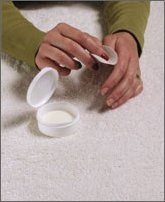Dangerous Toxic Fumes from Six Everyday Products that You Most Want to Avoid
by www.SixWise.com
While you may take great lengths to protect yourself and
your family from obvious poisons like rodent killers, chlorine
bleach and antifreeze, there are many others, many of them
household products, that can harm your health without warning.
The following products emit fumes that are best off avoided,
and, should you decide to use them, should be used with extreme
caution, only in well-ventilated areas and for as short a
duration as possible.
1. Oven Cleaner
Dangerous ingredients: Ethers, ethylene glycol, lye
(sodium and potassium hydroxide), methylene chloride, petroleum
distillates, pine oil
Health hazards: It is hard to avoid breathing in vapors
when using oven cleaner. The product is corrosive to skin
and eyes, and, when inhaled, to internal organs.
|

For a safe oven cleaning solution, sprinkle baking
soda on the dampened oven surface, let sit, then scrub
with steel wool.
|
Safety/Alternatives: Your best bet is to opt for a
self-cleaning oven so oven cleaners are not necessary. You
can cut down on their need also by putting a foil-lined cookie
sheet under foods to catch drippings, and cleaning spots right
after the oven cools (before baking them on again). If you
use oven cleaner, be sure to use heavy rubber gloves, an apron
and chemical splash goggles.
2. Oil-Based Paint
Dangerous ingredients: Alkyl resin, kerosene, lead,
lithopone, mercury, methylene chloride, methyl ethyl ketone,
mineral spirits, toluene, trichoroethane, xylene
Health hazards: There are 300 toxic chemicals and
150 carcinogens potentially present in oil-based paint, according
to a John Hopkins University study. Vapors easily accumulate
in closed spaces while painting. The fumes are toxic irritants
to the eyes, skin and lungs.
Safety/Alternatives: When using oil-based paint, use
a brush or roller rather than a sprayer and make sure ventilation
is adequate. Alternatively, look for latex water-based paints
or low-volatility paints (they have fewer toxic solvents).
3. Shoe Polish
Dangerous ingredients: Methylene chloride, mineral
spirits, nitrobenzene, silicones, trichloroethylene
Health hazards: Toxic ingredients are easily absorbed
through the skin or inhaled via the vapors, causing potential
harm to the skin and other organs.
Safety/Alternatives: Use the polishes that wipe on,
rather than spray on. You can also look for less toxic products
made from beeswax. For leather, try olive oil or cold-pressed
nut oil, buffed with a cloth until shiny.
4. Household Bug Foggers ("Bug Bombs")
Dangerous ingredients: Isobutane, N-Octyl bicycloheptene
dicarboximide, pyrethrum, permethrin, aromatic petroleum distillates
Health hazards: The U.S. Environmental Protection
Agency (EPA) has designated permethrin as a potential human
carcinogen. Other harmful ingredients in these pesticides
are toxic to eyes and skin and, if inhaled, can be toxic to
internal organs. Because these products contain aerosol propellants,
the toxins are expelled over a large area.
Safety/Alternatives: The U.S. EPA suggests taking
the following precautions when using a bug fogger in your
home:
- Use no more than one fogger per room, keeping in mind
that no more than 1 ounce of fogger per 1,000 ft should
be used.
- Extinguish all ignition sources, such as pilot lights,
or place fogger at lease 6 feet away from such sources.
- Remove all children, pets, toys, and uncovered food from
treated area.
- Properly ventilate the treated area after releasing foggers.
- Keep the product away from children, such as in a locked
cabinet or shed.
- Teach children not to touch pesticide products and other
household chemicals.
- Keep the telephone number of your local poison control
center or the toll-free number (1-800-222-1222) for the
National Poison Control Hotline handy.
5. Paint Thinner
Dangerous ingredients: Acetone, methanol, methyl ethyl
ketone, methyl isobutyl ketone, toluene, turpentine, mineral
spirits
Health hazards: The toxins in paint thinner may cause
health damage from long-term exposure. Some ingredients have
been linked to developmental effects (miscarriages/birth defects),
damage to the nervous system and reproductive effects, and
are mutagenic (could affect genes and chromosomes) and toxic
to the environment and wildlife.
|

Always be sure you have a window open when you remove
your nail polish.
|
Safety/Alternatives: Always were solvent-resistant
gloves and splash-guard goggles and keep the room well ventilated
when using paint thinner. Using water-based latex paints do
not require the use of paint thinner.
6. Nail Polish Remover
Dangerous ingredients: Acetone, ethyl acetate, benzophenone-1,
ethanol, isopropyl alcohol, propyl acetate, denatonium benzoate,
dimethyl adipate, propylene carbonate, toluene and formaldehyde
Health hazards: According to the Environmental Working
Group's Skin Deep Report, the ingredients in nail polish remover
pose the following health risks:
- Immune and nervous system toxicity
- Gastrointestinal and liver toxicity hazards
- Neurotoxicity hazards
- Damage to the skin and sense organs
- Possible reproductive or developmental harm
- General irritation
Safety/Alternatives: Use nail polish remover in a
well-ventilated area (not in a closed bathroom). There are
limited varieties of safer brands out there that contain fewer
chemicals (non-acetone varieties are widely available, but
still may contain other dangerous toxins). Check your local
health food store for options.
|
Keep Yourself, Your Family and Your
Pets Safe: Avoid Commercial Flea Treatments!
 Typical
flea and tick control products can be extremely
hazardous, some containing highly noxious nerve gas.
Still, these products have approval to be sold because
the claim is that the amount of such hazards is minimal
in the products. Typical
flea and tick control products can be extremely
hazardous, some containing highly noxious nerve gas.
Still, these products have approval to be sold because
the claim is that the amount of such hazards is minimal
in the products.
Flea collars and tags are
literally soaked in chemical pesticides, emitting a
continuous toxic cloud into the air, not only for your
pet, but you and your family.
To get rid of and prevent fleas and ticks, choose Flea
'n Tick B Gone instead: It is completely safe and does
not contain harmful pesticides or chemicals.
-
100% pesticide free
-
Non-toxic
-
Clinically proven to be highly effective
-
A Great Value! Eliminates
the need for collars, bombs, foggers, powders etc.
and is economically priced
-
Can also be used on bedding and pet areas of the
home--Simply lightly spray in these areas
-
Reduces vet and medicinal costs
-
Can safely be used as a preventive against fleas
and ticks: regular use can naturally break life
cycle of fleas
-
Controls other in-home pests
-
Reduces risk of infections, dermatitis and itching
-
Safely removes fleas, ticks, lice and other pests
Read
More and Order Now!
|
Recommended Reading
Cadmium
Poisoning, Which Can Harm Your Kidneys and Reduce Your Bone
Density, Surprisingly High
The
6 Most Dangerous Home-Based Causes of Disease and Illness
Sources
National
Institutes of Health: Household Products Database
Oregon
Toxics Alliance
U.S.
EPA: Safety Precautions for Home Release Foggers
Environmental
Working Group Skin Deep Report